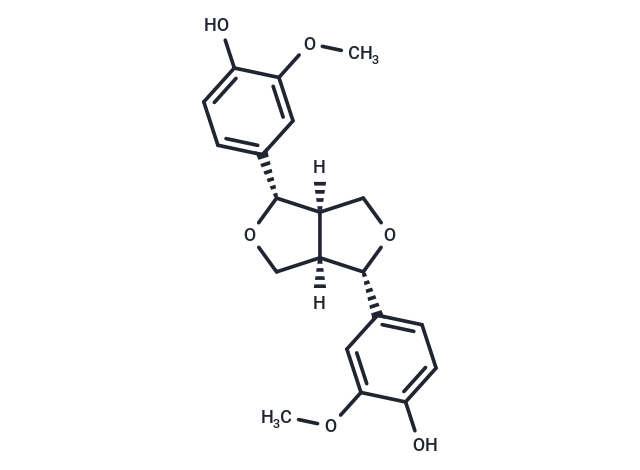Shopping Cart
- Remove All
 Your shopping cart is currently empty
Your shopping cart is currently empty

Pinoresinol ((+)-Pinoresinol) has antiinflammatory, hepatoprotective, and fungicidal activities, it can protect pial microcirculation from I-reperfusion injury, to increase nitric oxide release and to reduce oxidative stress preserving pial blood flow distribution; it may exert pharmacologically interesting effects via modulation of the insulin-like signalling pathway in C.elegans. Pinoresinol causes an upregulation of the CDK inhibitor p21(WAF1/Cip1) both at mRNA and protein levels, inhibits NF-kappaB and activating protein 1 (AP-1).

| Pack Size | Price | Availability | Quantity |
|---|---|---|---|
| 1 mg | $52 | In Stock | |
| 5 mg | $123 | In Stock | |
| 10 mg | $197 | In Stock | |
| 25 mg | $328 | In Stock | |
| 50 mg | $492 | In Stock | |
| 100 mg | $688 | In Stock | |
| 1 mL x 10 mM (in DMSO) | $137 | In Stock |
| Description | Pinoresinol ((+)-Pinoresinol) has antiinflammatory, hepatoprotective, and fungicidal activities, it can protect pial microcirculation from I-reperfusion injury, to increase nitric oxide release and to reduce oxidative stress preserving pial blood flow distribution; it may exert pharmacologically interesting effects via modulation of the insulin-like signalling pathway in C.elegans. Pinoresinol causes an upregulation of the CDK inhibitor p21(WAF1/Cip1) both at mRNA and protein levels, inhibits NF-kappaB and activating protein 1 (AP-1). |
| In vitro | Six lignan standards [secoisolariciresinol diglucoside (SDG), secoisolariciresinol (SECO), Pinoresinol (PINO), lariciresinol, matairesinol (MAT), and hydroxymatairesinol] and their colonic metabolites [enterolactone (ENL) and enterodiol] were studied. First, differentiated cells were exposed to SDG, SECO, PINO, or ENL at increasing concentrations for 4 h, and their cellular contents (before and after deconjugation) were determined by HPLC. Second, in IL-1β-stimulated confluent and/or differentiated cells, lignan effects were tested on different soluble proinflammatory mediators quantified by enzyme immunoassays and on the NF-κB activation pathway by using cells transiently transfected. SECO, PINO, and ENL, but not SDG, were taken up and partly conjugated by cells, which is a saturable conjugation process. PINO was the most efficiently conjugated (75% of total in cells). In inflamed cells, PINO significantly reduced IL-6 by 65% and 30% in confluent and differentiated cells, respectively, and cyclooxygenase (COX)-2-derived prostaglandin E(2) by 62% in confluent cells. In contrast, MAT increased significantly COX-2-derived prostaglandin E(2) in confluent cells. Moreover, PINO dose-dependently decreased IL-6 and macrophage chemoattractant protein-1 secretions and NF-κB activity[1] |
| Alias | (+)-Pinoresinol |
| Molecular Weight | 358.39 |
| Formula | C20H22O6 |
| Cas No. | 487-36-5 |
| Smiles | [H][C@]12CO[C@H](c3ccc(O)c(OC)c3)[C@@]1([H])CO[C@@H]2c1ccc(O)c(OC)c1 |
| Relative Density. | 1.287 g/cm3 |
| Storage | Powder: -20°C for 3 years | In solvent: -80°C for 1 year | Shipping with blue ice. | |||||||||||||||||||||||||
| Solubility Information | DMSO: 12 mg/mL (33.48 mM), Sonication is recommended. | |||||||||||||||||||||||||
Solution Preparation Table | ||||||||||||||||||||||||||
DMSO
| ||||||||||||||||||||||||||

Copyright © 2015-2025 TargetMol Chemicals Inc. All Rights Reserved.